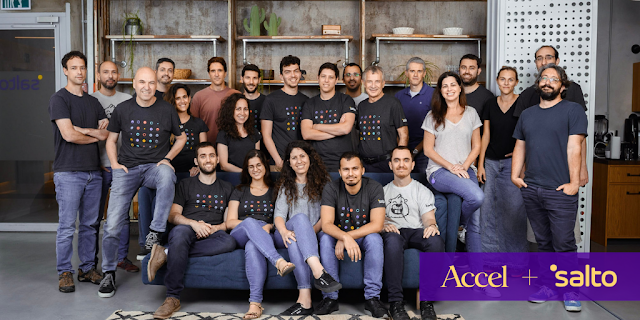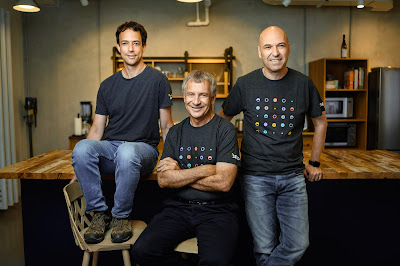
Team Salto in their Tel Aviv office
Around 10 years ago, I was lucky(!) enough to have the task of configuring Salesforce for our London team. While a great tool for many organizations of all sizes and across all industries, “lightly” customizing Salesforce for Accel’s internal use cases was neither a quick nor fun experience. Far from it. Fast forward to today, and the pain point is still here, but we now have a technology team to implement and run our tech stack, which includes, Salesforce, Netsuite, Slack, and many others. And while Salesforce has made some improvements when it comes to user experience, it still requires quite specific knowledge of its rules and syntax.
You might well ask: why is this more of a problem today than it was a few years ago? The answer is the cloud. As cloud computing and applications have become more prevalent in every size and type of company, configuring these applications remains a pain point that business operations and IT departments know all too well. And the configuration headaches don’t stop following the initial integration, they continue over applications’ years of use. To give some examples, Salesforce, NetSuite, HubSpot, ServiceNow, Workday, Coupa, Zuora, Workato, Marketo, Jira, Zendesk, Oracle, SAP Ariba and SuccessFactors, MSF Dynamics, SharePoint, and many others, form the core infrastructures of large and small companies worldwide. And yes, they all need to be configured to different degrees in order to address specific business needs. Some companies have up to 250 of these cloud applications and the configuration work gets even more complex when we think about cross-configuring those applications. For example, linking a certain Workday ID field with a Salesforce instance within the same organization, so when updating one custom field the system remains consistent and the process doesn’t break.
Today, the business application configuration problem is predominantly solved with the help of professional services. These include a mixture of implementation and configuration offerings from the cloud vendors themselves, along with system integrators. Technical teams that offer these services are usually trained and certified, for example, Salesforce and ServiceNow developers.
Given how complex some of these cloud application implementations and configurations are, the revenue pool is vast. To provide more color, the global Salesforce Services market alone is estimated at $14.5bn today, with Salesforce itself earning approximately $1bn in service revenues in the last year. There are multi-billion dollar service organizations built around the cloud application configuration market and, if we consider how many cloud applications there are, it’s clear this is one of the largest markets in technology that’s remained almost undisrupted since the cloud was born.
 Enter Salto. Co-founders Rami, Benny, and Gil - who previously built virtualization software company Ravello together (acquired by Oracle in 2016) - set out with the vision of bringing the same workflows and speed of release associated with DevOps into business application configurations. This would enable a more coordinated integration and configuration approach across cloud application silos, offering better visibility, speed, and consistency when adding and/or customizing cloud apps within the broader tech stack of businesses of all sizes.
Enter Salto. Co-founders Rami, Benny, and Gil - who previously built virtualization software company Ravello together (acquired by Oracle in 2016) - set out with the vision of bringing the same workflows and speed of release associated with DevOps into business application configurations. This would enable a more coordinated integration and configuration approach across cloud application silos, offering better visibility, speed, and consistency when adding and/or customizing cloud apps within the broader tech stack of businesses of all sizes.
To achieve this, they and the Salto team created a platform that extracts the configuration of tools such as Salesforce, NetSuite, and HubSpot via each application’s APIs. It then translates the configuration into a standardized readable file in a proprietary declarative programming language (NaCl, for “Not another Configuration Language”). The user can then edit the file to change the single cloud app configuration, as well as creating cross-app use-cases (e.g. Salesforce + Workday) and managing very complex tools such as CPQ. This is a powerful offering for any business operations or IT professional who wants to both visualize and amend/push in production configurations of business applications without having to know each application’s specific language and syntax.
"Over recent years we have seen big organizations adopting hundreds of business programs. Salto is the missing link as it applies principles ranging from software engineering to organizational data systems"
- Rami Tamir, CEO
We are excited excited to be partnering with a world-class team that has the bold vision, ambition, and determination to build a category-defining software business that creates value for users, cloud application vendors, and the entire ecosystem around them. Just as Snyk revolutionized the security industry by empowering developers, we believe the Salto team can revolutionize the business application configuration category, shifting it from a service to a software-addressed problem.
Congrats Team Salto for this $42m financing: onwards!
******************
 Enter Salto. Co-founders Rami, Benny, and Gil - who previously built virtualization software company Ravello together (acquired by Oracle in 2016) - set out with the vision of bringing the same workflows and speed of release associated with DevOps into business application configurations. This would enable a more coordinated integration and configuration approach across cloud application silos, offering better visibility, speed, and consistency when adding and/or customizing cloud apps within the broader tech stack of businesses of all sizes.
Enter Salto. Co-founders Rami, Benny, and Gil - who previously built virtualization software company Ravello together (acquired by Oracle in 2016) - set out with the vision of bringing the same workflows and speed of release associated with DevOps into business application configurations. This would enable a more coordinated integration and configuration approach across cloud application silos, offering better visibility, speed, and consistency when adding and/or customizing cloud apps within the broader tech stack of businesses of all sizes.
No comments:
Post a Comment